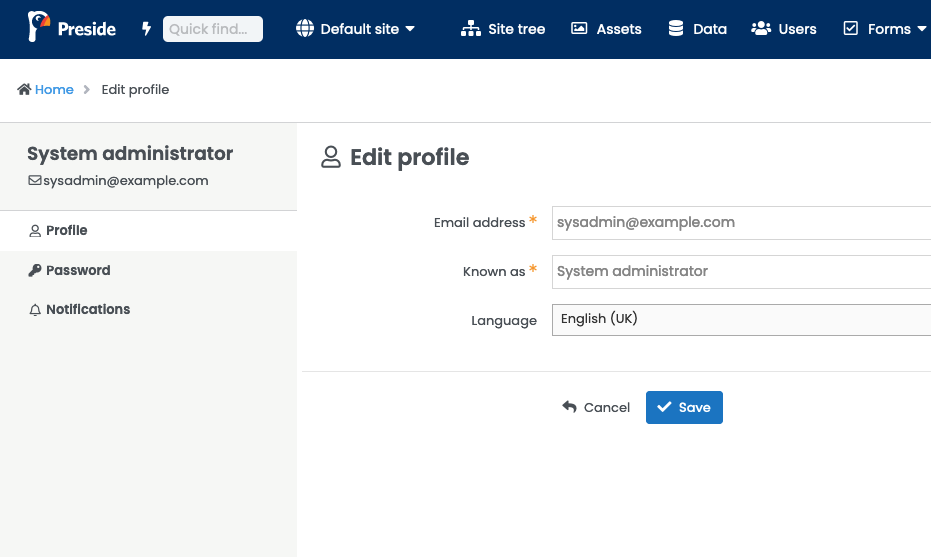The Alternate Admin Theme extension provides a refresh to the original Preside core admin layout and styling, while at the same time making it easy to customise and add styles to your admin application.
The most obvious change is that the main admin menu has moved from the left sidebar to the top of the page.
Before:
After:
The base font has also changed, as well as the look and feel of many buttons and components.
The theme can be used out-of-the-box with no further effort required. However, there are a number of areas you will likely wish to customise.
The top menu bar is driven by the new-style menu definition system introduced in Preside 10.17. See the following for more information:
Adding or modifying items in the top nav bar is just the same as in the left menu guide above, except that you define items in settings.admin.topNavItems.
When customising your menus, you might also wish to add or modify items in the System menu.
If you look at Config.cfc, you will find the following configuration options in settings.admin:
settings.admin = {
topNavItems = []
, topNavMenuIcons = true
, favicon = "/preside/system/assets/images/logos/favicon.png"
, adminAvatarSize = 56
, customCss = []
};
We've already seen how the topNavItems are used. The other options are:
topNavMenuIcons- boolean, whether or not to show icons in the top nav menufavicon- string, allows you to define your own favicon for use by the admin pagesadminAvatarSize- numeric, allows you to change the size of the admin user avatarcustomCss- an array of Sticker CSS assets which will be included in all admin requests, allowing you to easily add and override CSS definitions
There is a feature flag which allows you to enable or disable the site switcher in the menu bar (it's enabled by default):
settings.features.siteSwitcher.enabled = true;
If setting it to false, you will probably want to add the sitemanager menu item somewhere in your admin menus.
The customCss setting above allows you to add your own CSS for use by the admin pages.
Although you can use this to override CSS rules, the majority of commonly customised styling has been set up using CSS custom properties (CSS variables), which means you don't need to override multiple rules or sprinkle numberous !important declarations in your CSS!
Here is a simple example which shows setting the navbar background colour to dark green, and setting custom images for the login screen background and logo:
:root {
--navbar-color : #10460d;
--login-bg-image : url( "/assets/images/backgrounds/login-background.jpg" );
--login-logo : url( "/assets/images/my-company-logo.svg" );
--login-logo-width : auto;
--login-logo-height : 100px;
}For a full list of the CSS properties available for you to use, look at the source of /assets/css/admin/altadmintheme/variables.less.
With the main navigation moved to the top of the page, this frees up the side of the page for secondary navigation. Basic functionality is provided to insert your content in here; an example of this is built in to the extension's customisation of the admin user Edit Profile page:
Set an array of menu items (defined as per the main menus) into prc.adminSidebarItems, and the menu will be rendered in the sidebar. These menus can be nested several levels deep, and will auto-expand when clicked. Note that the parent of children will not itself be a link; it just acts as a title and open/close trigger for the child menu.
If displaying a sidebar menu, you may optionally specify a header panel by setting rendered HTML into prc.adminSidebarHeader. This might contain basic information about a record, for instance.


